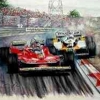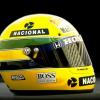Quote
Originally posted by Ogami musashi
The fastest is a bonus, what i want is fast.
I don't agree formula 1 was not always the fastest, okay i may only start from 1980 but since then F1 cars were the fastest. Group C/GTP cars that sometimes posted similar lap times were on qualifying runs and their race lap times (even for the 500km sprint races of group C) were completely off.
The Group C cars were slower due the higher minimum weight and because their races were significantly longer. But Can-Am cars were faster and technically most advanced.
Quote
Why should F1 be the fastest? because fast driving is hard. This is the first simple reason, the second is that designing the fastest car is an engineering experience, especially designing a car able of being the fastest for a whole race (look at today race lap times only 2 seconds off the qualifying ones).
The current race times are about two seconds of the qualifying times mostly due the post-qualifying parc fermé regulations, tyre regulations and refuelling. With a proper qualifying format, a massive deregulation of the tyres and ban on pit stops the races times would be at least five seconds off the qualifying times.
But pace isn't everything. A car isn't harder to driver if it's faster as well. In most cases a faster car is easier to drive. The 1983 flat bottomed Formula 1 cars were harder and at least three seconds slower on most tracks compared to their 1982 ground effected predecessors.
Quote
I don't understand why you think downforce is a stopper for other technologies??? downforce is no magical you still have to use tyres suspension and chassis and suspension and chassis are still developped today.
Well, tyre development for instance was heavily curtailed and finally even banned. The cornering speeds played a big role in the FIA decision to introduce both grooved and standardized tyres.




























